2012 MERCEDES-BENZ GL wheel
[x] Cancel search: wheelPage 20 of 384

Maximum ....................................... 344
Notes ............................................. 343
Not reached (TIREFIT) ....................319
Pressure loss warning ....................345
Reached (TIREFIT) ..........................320
Recommended ............................... 341
Tire pressure monitoring system
Function/notes ............................. 347
Restarting ...................................... 349
Warning lamp ................................. 265
Tires
Aspect ratio (definition) .................361
Average weight of the vehicle
occupants (definition) ....................359
Bar (definition) ............................... 359
Characteristics .............................. 359
Checking ........................................ 339
Definition of terms .........................359
Direction of rotation ......................362
Display message ............................ 252
Distribution of the vehicle
occupants (definition) ....................362
DOT, Tire Identification Number
(TIN) ............................................... 358
DOT (Department of
Transportation) (definition) ............359
GAWR (Gross Axle Weight Rating)
(definition) ..................................... 360
GTW (Gross Trailer Weight)
(definition) ..................................... 360
GVW (Gross Vehicle Weight)
(definition) ..................................... 360
GVWR (Gross Vehicle Weight
Rating) (definition) .........................360
Important safety notes ..................338
Increased vehicle weight due to
optional equipment (definition) ......359
Kilopascal (kPa) (definition) ...........360
Labeling (overview) ........................355
Load bearing index (definition) ......361
Load index ..................................... 358
Load index (definition) ...................360
Maximum loaded vehicle weight
(definition) ..................................... 360
Maximum load on a tire
(definition) ..................................... 361
Maximum permissible tire
pressure (definition) ....................... 360Maximum tire load .........................353
Maximum tire load (definition) .......360
Optional equipment weight
(definition) ..................................... 361
PSI (pounds per square inch)
(definition) ..................................... 361
Replacing ....................................... 362
Service life ..................................... 339
Sidewall (definition) .......................361
Speed index (definition) .................360
Storing ........................................... 363
Structure and characteristics
(definition) ..................................... 359
Temperature .................................. 355
TIN (Tire Identification Number)
(definition) ..................................... 361
Tire bead (definition) ......................361
Tire pressure (definition) ................361
Tire pressures (recommended) ......359
Tire size (data) ............................... 363
Tire size designation, load-bearing
capacity, speed index ....................356
Tire tread ....................................... 339
Tire tread (definition) .....................361
Total load limit (definition) .............362
Traction ......................................... 354
Traction (definition) .......................361
Tread wear ..................................... 354
TWR (permissible trailer drawbar
noseweight) (definition) .................361
Uniform Tire Quality Grading
Standards ...................................... 354
Uniform Tire Quality Grading
Standards (definition) ....................359
Unladen weight (definition) ............360
Wear indicator (definition) .............362
Wheel rim (definition) ....................360
see Flat tire
Top Tether ............................................ 64
Towing Important safety guidelines ...........331
Installing the towing eye ................331
Removing the towing eye ...............332
Towing a trailer
Coupling up a trailer ......................210
Decoupling a trailer .......................212
Driving tips .................................... 210
Important safety notes ..................21018Index
Page 22 of 384

W
Warning and indicator lamps ABS ................................................ 260
Brakes ........................................... 259
Check Engine ................................. 264
Cruise control ................................ 180
Distance warning ........................... 265
ESP ®
.............................................. 261
ESP ®
OFF ....................................... 262
Fuel tank ........................................ 264
LIM (DISTRONIC) ........................... 184
Overview .......................................... 30
PASSENGER AIRBAG OFF
indicator lamp .................................. 45
PASSENGER AIR BAG OFF
indicator lamp (only Canada) ...........50
PASSENGER AIR BAG OFF
indicator lamp (only USA) ................45
Reserve fuel ................................... 264
Seat belt ........................................ 258
SRS ................................................ 263
Tire pressure monitor ....................265
Warranty ............................................ 368
Washer fluid Display message ............................ 256
see Windshield washer system
Weight
see Technical data
Wheel bolt tightening torque ........... 325
Wheel chock ...................................... 321
Wheels Changing/replacing .......................362
Changing a wheel .......................... 321
Checking ........................................ 339
Cleaning ......................................... 307
Important safety notes ..................338
Mounting a wheel .......................... 324
Removing a wheel ..........................323
Storing ........................................... 363
Tightening torque ........................... 325
Wheel size/tire size .......................363
Window curtain air bag ....................... 44
Windows Cleaning ......................................... 309
see Side windows Windshield
Defrosting ...................................... 142
Infrared reflective .......................... 297
Windshield washer system .............. 303
Notes ............................................. 377
Windshield wipers
Problem (malfunction) ...................131
Rear window wiper ........................129
Replacing the wiper blades ............129
Switching on/off ........................... 128
Winter driving
Important safety notes ..................340
Slippery road surfaces ...................174
Snow chains .......................... 173, 341
Winter operation
Radiator cover ............................... 301
Winter tires
M+S tires ............................... 172, 340
Wiper blades
Cleaning ......................................... 309
Important safety notes ..................129
Replacing (rear window) ................130
Replacing (windshield) ...................130
Wooden trim (cleaning
instructions) ...................................... 31120Index
Page 25 of 384
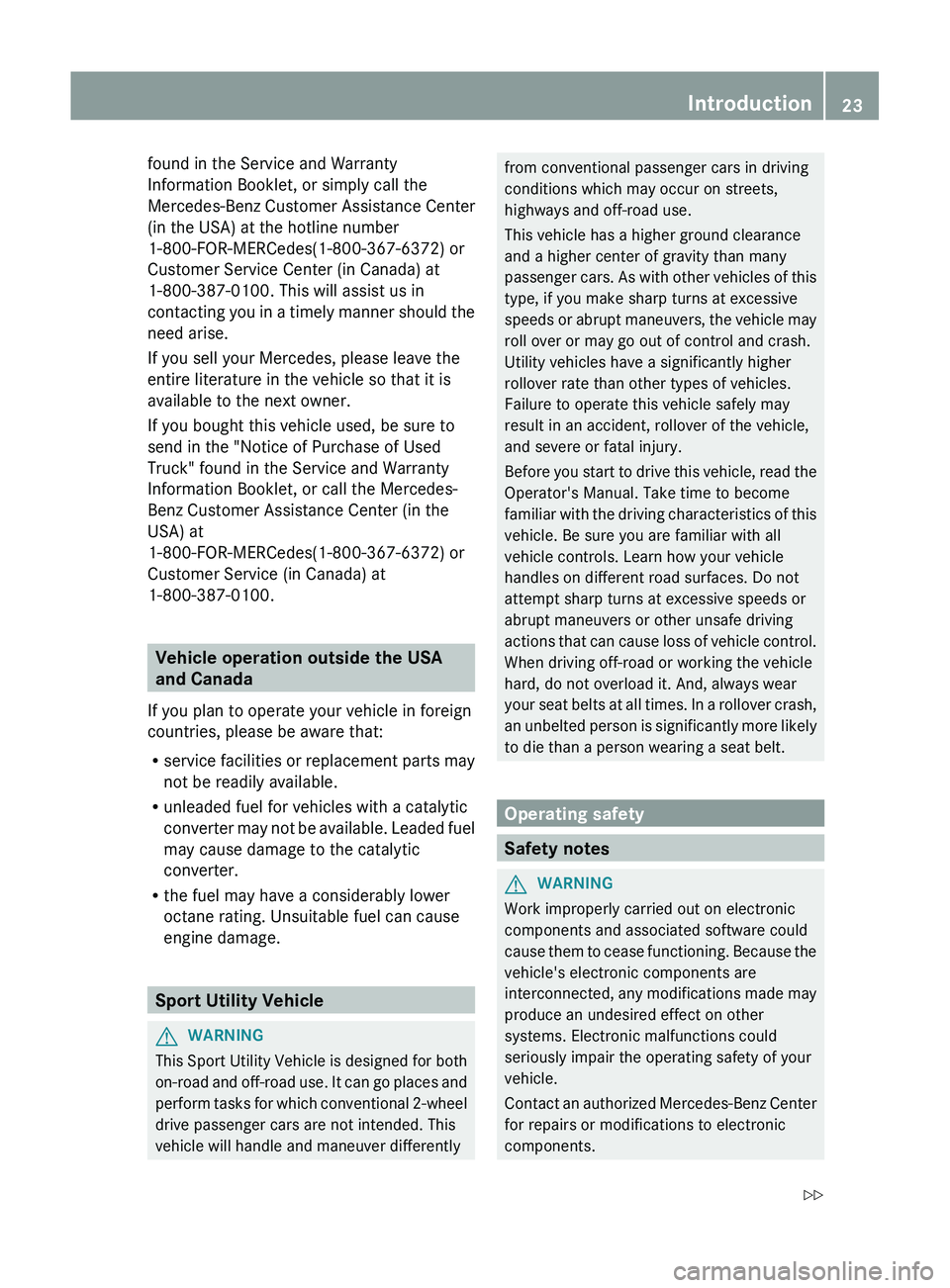
found in the Service and Warranty
Information Booklet, or simply call the
Mercedes-Benz Customer Assistance Center
(in the USA) at the hotline number
1-800-FOR-MERCedes(1-800-367-6372) or
Customer Service Center (in Canada) at
1-800-387-0100. This will assist us in
contacting you in a timely manner should the
need arise.
If you sell your Mercedes, please leave the
entire literature in the vehicle so that it is
available to the next owner.
If you bought this vehicle used, be sure to
send in the "Notice of Purchase of Used
Truck" found in the Service and Warranty
Information Booklet, or call the Mercedes-
Benz Customer Assistance Center (in the
USA) at
1-800-FOR-MERCedes(1-800-367-6372) or
Customer Service (in Canada) at
1-800-387-0100.
Vehicle operation outside the USA
and Canada
If you plan to operate your vehicle in foreign
countries, please be aware that:
R service facilities or replacement parts may
not be readily available.
R unleaded fuel for vehicles with a catalytic
converter may not be available. Leaded fuel
may cause damage to the catalytic
converter.
R the fuel may have a considerably lower
octane rating. Unsuitable fuel can cause
engine damage.
Sport Utility Vehicle
GWARNING
This Sport Utility Vehicle is designed for both
on-road and off-road use. It can go places and
perform tasks for which conventional 2-wheel
drive passenger cars are not intended. This
vehicle will handle and maneuver differently
from conventional passenger cars in driving
conditions which may occur on streets,
highways and off-road use.
This vehicle has a higher ground clearance
and a higher center of gravity than many
passenger cars. As with other vehicles of this
type, if you make sharp turns at excessive
speeds or abrupt maneuvers, the vehicle may
roll over or may go out of control and crash.
Utility vehicles have a significantly higher
rollover rate than other types of vehicles.
Failure to operate this vehicle safely may
result in an accident, rollover of the vehicle,
and severe or fatal injury.
Before you start to drive this vehicle, read the
Operator's Manual. Take time to become
familiar with the driving characteristics of this
vehicle. Be sure you are familiar with all
vehicle controls. Learn how your vehicle
handles on different road surfaces. Do not
attempt sharp turns at excessive speeds or
abrupt maneuvers or other unsafe driving
actions that can cause loss of vehicle control.
When driving off-road or working the vehicle
hard, do not overload it. And, always wear
your seat belts at all times. In a rollover crash,
an unbelted person is significantly more likely
to die than a person wearing a seat belt.
Operating safety
Safety notes
GWARNING
Work improperly carried out on electronic
components and associated software could
cause them to cease functioning. Because the
vehicle's electronic components are
interconnected, any modifications made may
produce an undesired effect on other
systems. Electronic malfunctions could
seriously impair the operating safety of your
vehicle.
Contact an authorized Mercedes-Benz Center
for repairs or modifications to electronic
components.
Introduction23Z
Page 26 of 384

Other improper work or modifications on the
vehicle could also have a negative impact on
the operating safety of the vehicle.
Some safety systems only function when the
engine is running. You should therefore never
turn off the engine while driving.GWARNING
Heavy blows against the vehicle underbody or
tires/wheels may cause serious damage and
impair the operating safety of your vehicle.
Such blows can be caused, for example, by
running over an obstacle, road debris or a
pothole.
If you feel a sudden significant vibration or
ride disturbance, or you suspect that damage
to your vehicle has occurred:
R turn on your hazard warning flashers.
R slow down carefully.
R drive with caution to an area which is a safe
distance from the road.
Inspect the vehicle underbody and tires/
wheels for possible damage. If the vehicle
appears unsafe, have it towed to the nearest
authorized Mercedes-Benz Center or other
qualified maintenance or repair facility for
further inspection or repairs.
Qualified specialist workshop
An authorized Mercedes-Benz Center is a
qualified specialist workshop. It has the
necessary specialist knowledge, tools and
qualifications to correctly carry out the work
required on your vehicle. This is especially the
case for work relevant to safety.
Observe the notes in the service booklet.
Always have the following work carried out at
an authorized Mercedes-Benz Center:
R work relevant to safety
R service and maintenance work
R repair work
Ralterations, installation work and
modifications
R work on electronic components
Proper use
GWARNING
There are various warning stickers affixed to
your vehicle. Their purpose is to alert you and
others to various dangers. Therefore, do not
remove any warning stickers unless the
sticker clearly states that you may do so.
If you remove any warning stickers, you or
others could fail to recognize certain dangers
and be injured.
The proper use of the vehicle requires that
you familiarize yourself with the following
information and rules:
R safety notes in this Operator's Manual
R technical data in this Operator's Manual
R traffic rules and regulations
R laws and safety standards pertaining to
motor vehicles
Problems with your vehicle
If you should experience a problem with your
vehicle, particularly one that you believe may
affect its safe operation, we urge you to
contact an authorized Mercedes-Benz Center
immediately to have the problem diagnosed
and rectified. If the problem is not resolved to
your satisfaction, please discuss the problem
again with a Mercedes-Benz Center or
contact us at one of the following addresses.
In the USA
Customer Assistance Center
Mercedes-Benz USA, LLC
One Mercedes Drive
Montvale, NJ 07645-0350
24Introduction
Page 29 of 384
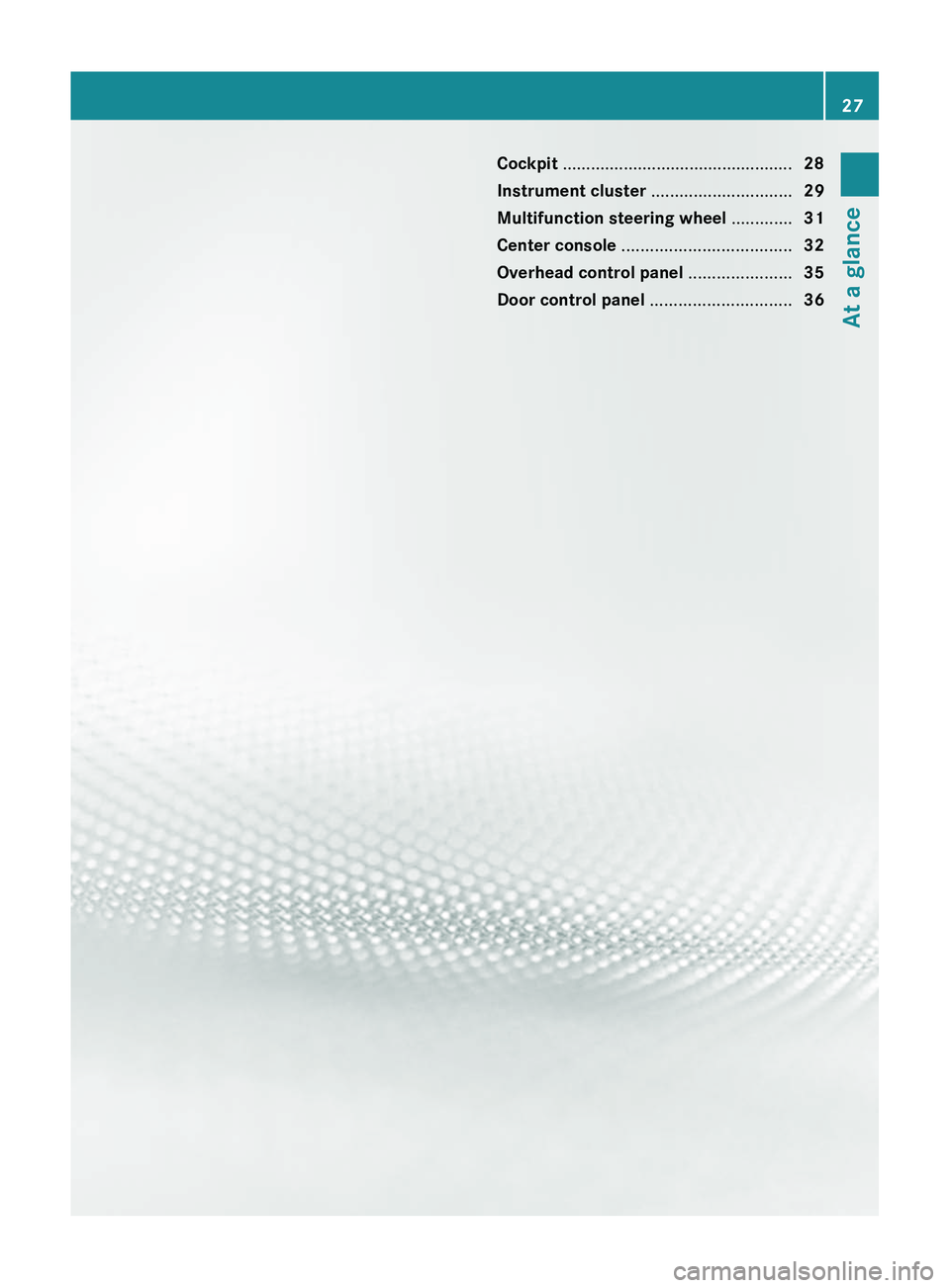
Cockpit ................................................. 28
Instrument cluster ..............................29
Multifunction steering wheel .............31
Center console .................................... 32
Overhead control panel ......................35
Door control panel .............................. 3627At a glance
Page 30 of 384
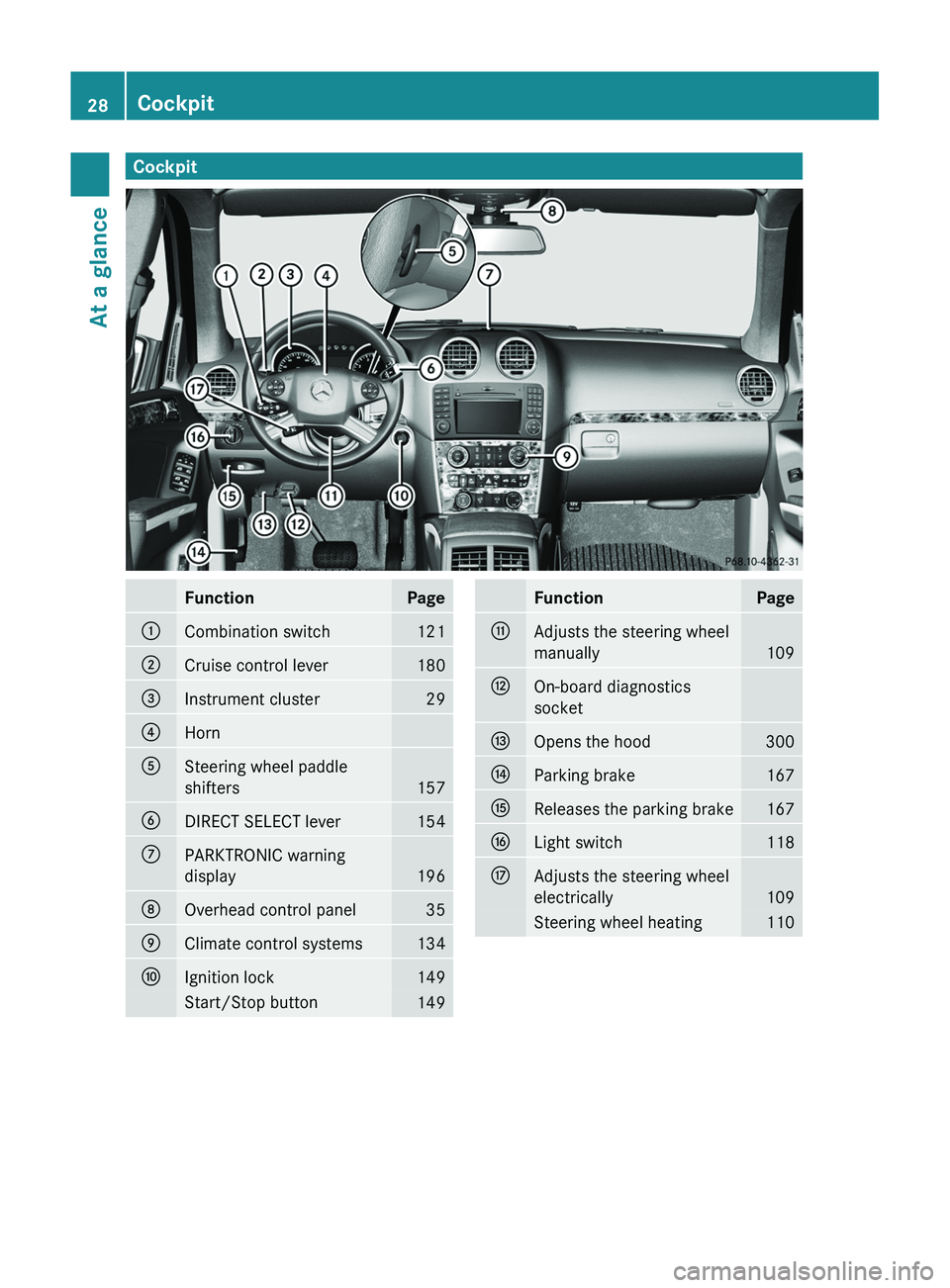
CockpitFunctionPage:Combination switch121;Cruise control lever180=Instrument cluster29?HornASteering wheel paddle
shifters
157
BDIRECT SELECT lever154CPARKTRONIC warning
display
196
DOverhead control panel35EClimate control systems134FIgnition lock149Start/Stop button149FunctionPageGAdjusts the steering wheel
manually
109
HOn-board diagnostics
socketIOpens the hood300JParking brake167KReleases the parking brake167LLight switch118MAdjusts the steering wheel
electrically
109
Steering wheel heating11028CockpitAt a glance
Page 33 of 384
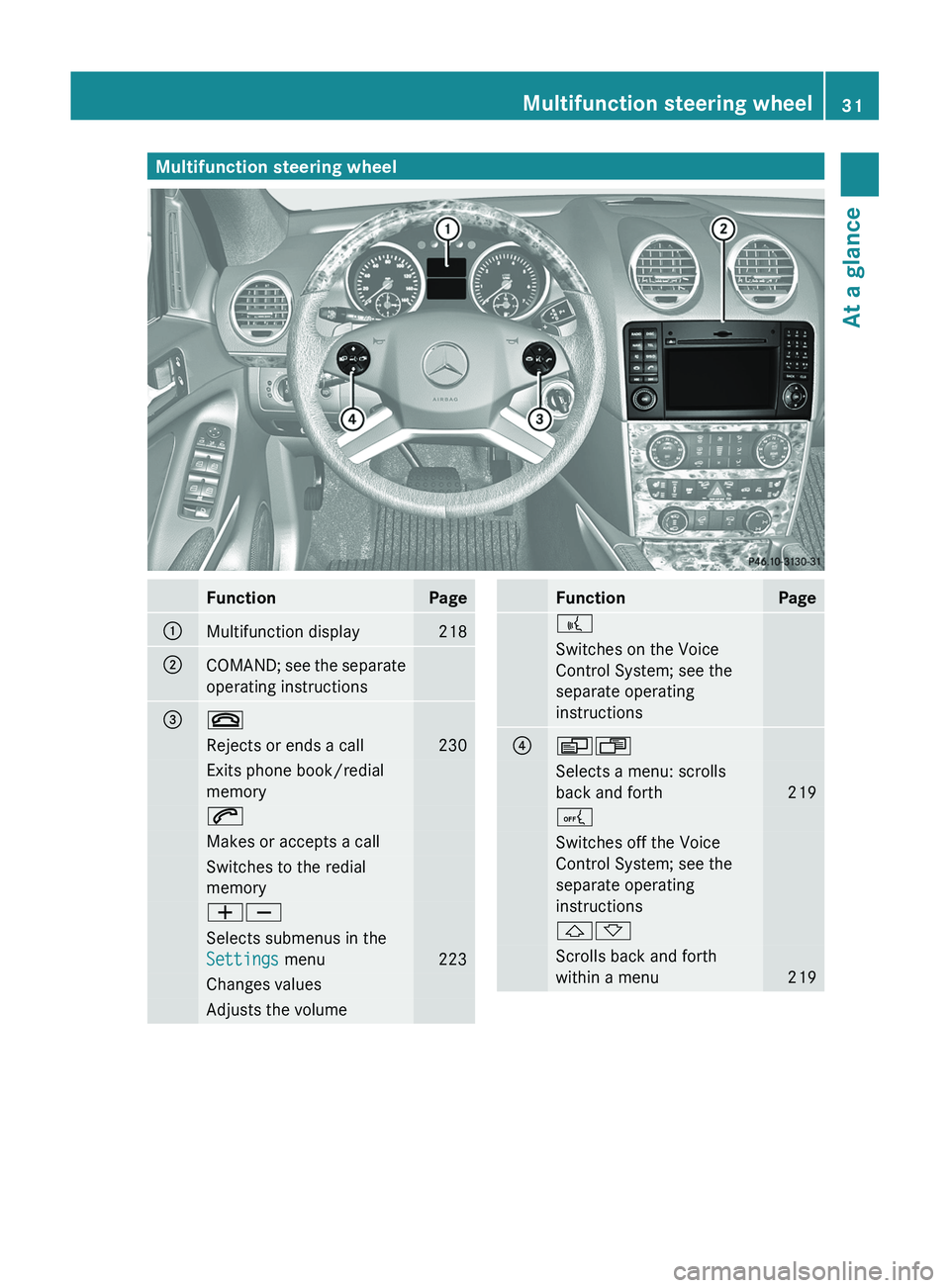
Multifunction steering wheelFunctionPage:Multifunction display218;COMAND; see the separate
operating instructions=~Rejects or ends a call230Exits phone book/redial
memory6Makes or accepts a callSwitches to the redial
memoryWXSelects submenus in the
Settings menu
223
Changes valuesAdjusts the volumeFunctionPage?Switches on the Voice
Control System; see the
separate operating
instructions?VUSelects a menu: scrolls
back and forth
219
ASwitches off the Voice
Control System; see the
separate operating
instructions&*Scrolls back and forth
within a menu
219
Multifunction steering wheel31At a glance
Page 41 of 384
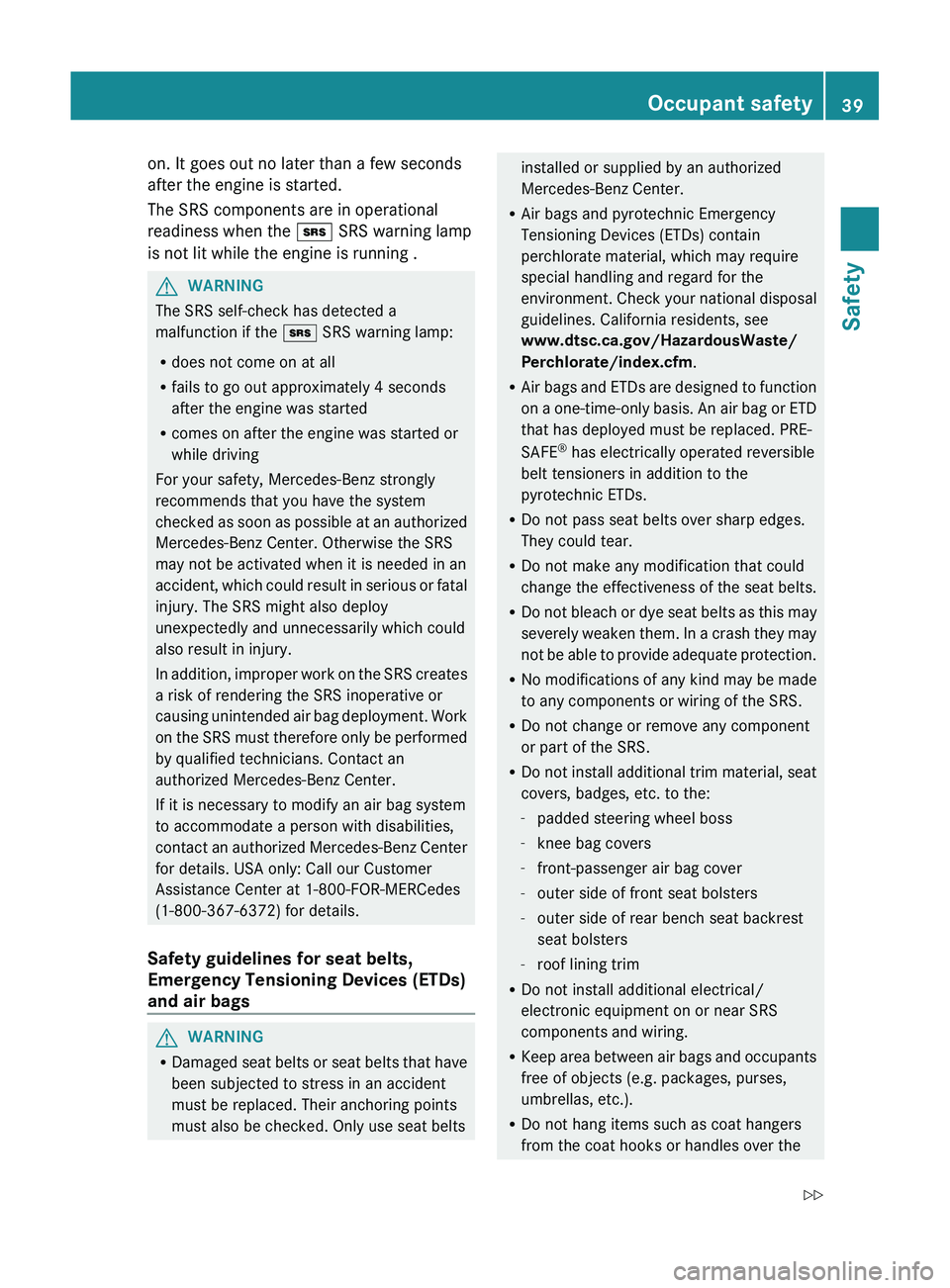
on. It goes out no later than a few seconds
after the engine is started.
The SRS components are in operational
readiness when the + SRS warning lamp
is not lit while the engine is running .GWARNING
The SRS self-check has detected a
malfunction if the + SRS warning lamp:
R does not come on at all
R fails to go out approximately 4 seconds
after the engine was started
R comes on after the engine was started or
while driving
For your safety, Mercedes-Benz strongly
recommends that you have the system
checked as soon as possible at an authorized
Mercedes-Benz Center. Otherwise the SRS
may not be activated when it is needed in an
accident, which could result in serious or fatal
injury. The SRS might also deploy
unexpectedly and unnecessarily which could
also result in injury.
In addition, improper work on the SRS creates
a risk of rendering the SRS inoperative or
causing unintended air bag deployment. Work
on the SRS must therefore only be performed
by qualified technicians. Contact an
authorized Mercedes-Benz Center.
If it is necessary to modify an air bag system
to accommodate a person with disabilities,
contact an authorized Mercedes-Benz Center
for details. USA only: Call our Customer
Assistance Center at 1-800-FOR-MERCedes
(1-800-367-6372) for details.
Safety guidelines for seat belts,
Emergency Tensioning Devices (ETDs)
and air bags
GWARNING
R Damaged seat belts or seat belts that have
been subjected to stress in an accident
must be replaced. Their anchoring points
must also be checked. Only use seat belts
installed or supplied by an authorized
Mercedes-Benz Center.
R Air bags and pyrotechnic Emergency
Tensioning Devices (ETDs) contain
perchlorate material, which may require
special handling and regard for the
environment. Check your national disposal
guidelines. California residents, see
www.dtsc.ca.gov/HazardousWaste/
Perchlorate/index.cfm .
R Air bags and ETDs are designed to function
on a one-time-only basis. An air bag or ETD
that has deployed must be replaced. PRE-
SAFE ®
has electrically operated reversible
belt tensioners in addition to the
pyrotechnic ETDs.
R Do not pass seat belts over sharp edges.
They could tear.
R Do not make any modification that could
change the effectiveness of the seat belts.
R Do not bleach or dye seat belts as this may
severely weaken them. In a crash they may
not be able to provide adequate protection.
R No modifications of any kind may be made
to any components or wiring of the SRS.
R Do not change or remove any component
or part of the SRS.
R Do not install additional trim material, seat
covers, badges, etc. to the:
- padded steering wheel boss
- knee bag covers
- front-passenger air bag cover
- outer side of front seat bolsters
- outer side of rear bench seat backrest
seat bolsters
- roof lining trim
R Do not install additional electrical/
electronic equipment on or near SRS
components and wiring.
R Keep area between air bags and occupants
free of objects (e.g. packages, purses,
umbrellas, etc.).
R Do not hang items such as coat hangers
from the coat hooks or handles over theOccupant safety39SafetyZ